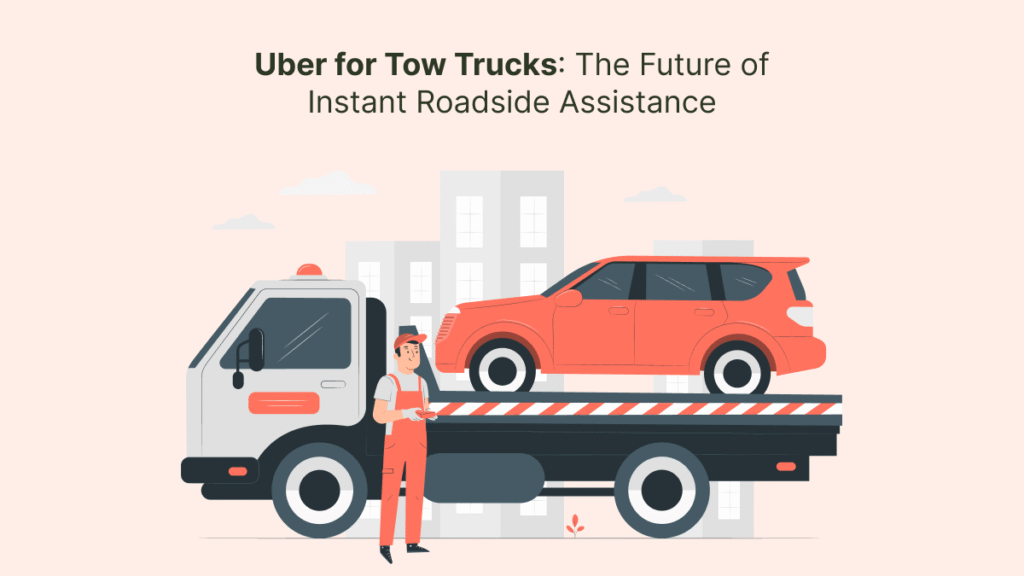In 2025, the concept of “Uber for X” has expanded far beyond ridesharing. One of the most impactful and fast-growing adaptations is the Uber for Tow Trucks model, designed to provide instant roadside assistance. This modern approach is revolutionizing how drivers get help when stranded, replacing long waits and frustrating calls with a simple app-based solution. Whether it’s a flat tire, dead battery, or an accident requiring vehicle recovery, these platforms connect users with the nearest available tow truck in real-time, offering convenience, speed, and reliability. With the global towing services market steadily growing, the digital transformation in roadside assistance is more than just a trend—it’s the new standard. Businesses entering this space can gain a competitive edge by adopting an Uber-like on-demand platform tailored to the towing industry.
The Problem with Traditional Towing Services
For decades, getting roadside assistance meant calling a towing company, describing your location (often with vague landmarks), and waiting without knowing when help would arrive. Pricing was inconsistent, customer experience varied, and tracking the tow truck’s arrival was nearly impossible. This outdated system frustrated customers and limited towing companies’ operational efficiency. Today’s drivers expect faster response times, transparent pricing, real-time updates, and cashless transactions—all of which traditional towing methods often fail to deliver. This gap in service created the perfect opportunity for an on-demand towing solution modeled after Uber’s ride-hailing success.
How Uber for Tow Trucks Works
The Uber for Tow Trucks model leverages mobile app technology to connect stranded motorists with nearby tow truck operators. Here’s how it typically works:
- Request a Tow: The driver uses the app to request assistance, selecting the type of service needed—flatbed towing, winching, battery jumpstart, tire change, or fuel delivery.
- Real-Time Matching: The platform automatically matches the request with the closest available tow truck, ensuring faster arrival times.
- Live Tracking: Users can track the tow truck’s location in real-time, reducing uncertainty and wait-time anxiety.
- Transparent Pricing: Fare estimates are shown upfront, eliminating unexpected charges.
- Cashless Payment: Payments are processed securely through the app, offering convenience for both customers and operators.
- Ratings and Reviews: Customers rate the service, helping maintain quality standards.
Benefits for Customers
Adopting this model dramatically improves the roadside assistance experience for motorists:
- Faster Response Times: GPS tracking ensures the nearest tow truck is dispatched immediately.
- 24/7 Availability: Customers can get help anytime, anywhere.
- Safety and Transparency: Driver profiles, ratings, and service details are visible before arrival.
- Multiple Service Options: Beyond towing, drivers can request battery replacements, lockout help, or fuel delivery.
- Stress-Free Payments: No need for cash—everything is handled digitally.
Benefits for Tow Truck Operators
For tow truck businesses, joining or launching an Uber-like platform offers:
- Increased Job Opportunities: Operators receive more service requests from app users.
- Efficient Routing: GPS optimization reduces travel time and fuel costs.
- Steady Revenue: On-demand access to customers helps fill downtime between jobs.
- Reputation Building: Ratings and reviews showcase reliability and professionalism.
- Data Insights: Business owners can track demand patterns and adjust operations accordingly.
Technology Behind Uber for Tow Trucks
To make this model work, a robust tech infrastructure is essential:
- Customer App: For requesting assistance, tracking, and payments.
- Driver App: For receiving job requests, navigation, and status updates.
- Admin Panel: For managing users, operators, pricing, and analytics.
- GPS and Mapping Integration: Accurate location detection and optimal route planning.
- Payment Gateway: Secure, fast, and reliable payment processing.
- Push Notifications: Instant updates for job confirmation and arrival alerts.
Partnering with a skilled clone app development company can significantly speed up the creation of such a platform, as they can customize an Uber clone script for towing services with minimal development time.
Monetization Opportunities
The Uber for Tow Trucks model isn’t just about convenience—it’s a profitable business opportunity. Revenue streams can include:
- Commission per Booking: Charging operators a percentage of each completed job.
- Subscription Plans: Offering monthly memberships for customers needing frequent assistance.
- Advertising: Featuring partner auto repair shops, insurance providers, or car accessory brands.
- Premium Services: Charging extra for priority dispatch, long-distance towing, or specialized vehicle handling.
Read More: Build a Roadside Assistance App like Uber for Tow Truck
Market Potential
The demand for on-demand towing is rising due to the increasing number of vehicles on the road, unpredictable breakdowns, and customers’ shift toward mobile-first solutions. Insurance companies and roadside assistance providers are also partnering with tech-driven towing platforms to enhance customer service. According to industry reports, the global roadside assistance market is projected to grow significantly through 2030, with Asia-Pacific markets, including Malaysia, India, and Indonesia, showing strong adoption rates for on-demand roadside apps.
Steps to Launch Your Uber for Tow Trucks App
- Market Research: Identify your target audience and local towing needs.
- Choose a Business Model: Decide whether to operate your own fleet or partner with independent operators.
- Select the Right Technology Partner: Work with a clone app development company to build a reliable, scalable platform.
- Integrate Essential Features: Include real-time tracking, multiple service options, and secure payments.
- Onboard Drivers: Ensure they meet quality and safety standards.
- Launch Marketing Campaigns: Use digital marketing, partnerships with insurance providers, and roadside ads to attract users.
- Offer Promotions: Give discounts or free trials to encourage first-time users.
Future Trends in On-Demand Roadside Assistance
The Uber for Tow Trucks concept is evolving with new technologies:
- Electric Vehicle (EV) Support: Providing mobile EV charging for stranded electric cars.
- AI-Powered Dispatch: Predicting demand and dispatching trucks proactively.
- Integration with Connected Cars: Automatically sending tow requests when a vehicle detects a breakdown.
- Subscription-Based Protection Plans: Offering unlimited tows for a flat monthly fee.
- Blockchain-Based Payments: Enhancing transparency and security in transactions.
Why Now Is the Time to Invest
In the competitive roadside assistance industry, speed, technology, and customer experience are everything. By launching an Uber-like tow truck app now, entrepreneurs can position themselves as leaders in a growing market before it becomes saturated. The model’s scalability means it can start in one city and expand regionally or nationally with minimal operational changes. With vehicle ownership on the rise and digital convenience becoming the norm, the Uber for Tow Trucks concept isn’t just the future—it’s the present. A clone app development company can help you enter this market in weeks instead of years, giving you a head start in building brand recognition and customer loyalty.
Final Thoughts
The future of roadside assistance is instant, transparent, and app-driven. Uber for Tow Trucks offers benefits for both customers and operators, bridging the gap between urgent need and quick service. With the right technology partner, businesses can launch feature-rich, scalable platforms that meet today’s customer expectations. For entrepreneurs ready to innovate in the automotive service industry, now is the time to leverage on-demand app technology and redefine roadside assistance.
FAQs
What is an Uber for Tow Trucks app?
It’s an on-demand mobile platform that connects drivers in need of roadside assistance with nearby tow truck operators in real time.
How much does it cost to develop an Uber-like towing app?
Costs vary based on features, design, and technology used, but working with a clone app development company can significantly reduce expenses.
Can the app offer services beyond towing?
Yes, many platforms also offer battery jumpstarts, fuel delivery, tire changes, and lockout assistance.
How do tow truck operators benefit from such platforms?
They get more job requests, better routing efficiency, and increased revenue through higher visibility.
Is this business model scalable?
Absolutely. The Uber for Tow Trucks concept can be expanded from a single city to multiple regions with minimal adjustments







